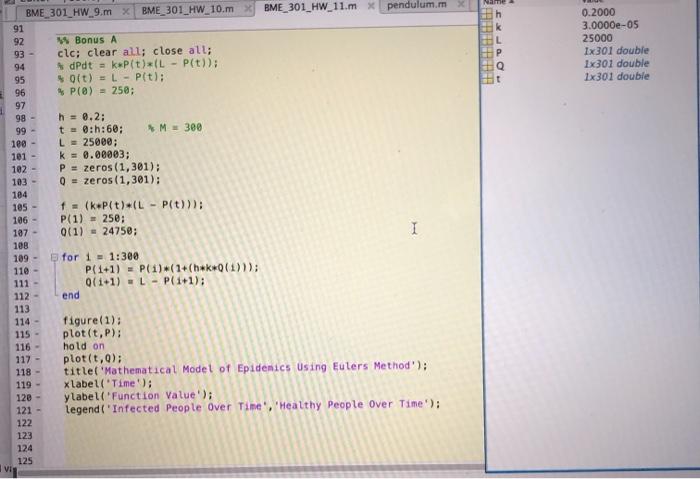Answered step by step
Verified Expert Solution
Question
1 Approved Answer
BME 301_HW_9.mx 91 92 93- 94 95 96 97 98 99 100 101 CRE h = 0.2; t = 0:h:60; L = 25000; k=

BME 301_HW_9.mx 91 92 93- 94 95 96 97 98 99 100 101 CRE h = 0.2; t = 0:h:60; L = 25000; k= 0.00003; 102 P= zeros (1,301); 103 - Q zeros (1,301); 104 105- 106 107 108 109- 110- 111- ** 112 113 114 115 116- 117- 118- 119- 120 121- 122 123 124 125 * Bonus A cle; clear all; close all; %dPdt= k*P(t)*(L - P(t)); Q(t)= L P(t); % P(0) = 250; BME 301_HW_10.m for 11:300 f (k+P(t)*(L- P(1) = 250; 0(1) 24756 end *M = 300 P(t))); P(1+1)= P(1)*(1+(h*k*Q(1))); Q(1+1)= LP(1+1); BME 301_HW_11.m x pendulum.m figure (1); plot(t,P); hold on plot(t,0); title( 'Mathematical Model of Epidemics Using Eulers Method'); xlabel('Time'); ylabel('Function Value'); Legend('Infected People Over Time', 'Healthy People Over Time'); 238889 FKLPOL 0.2000 3.0000-05 25000 1x301 double 1x301 double 1x301 double
Step by Step Solution
★★★★★
3.38 Rating (151 Votes )
There are 3 Steps involved in it
Step: 1

Get Instant Access to Expert-Tailored Solutions
See step-by-step solutions with expert insights and AI powered tools for academic success
Step: 2

Step: 3

Ace Your Homework with AI
Get the answers you need in no time with our AI-driven, step-by-step assistance
Get Started


